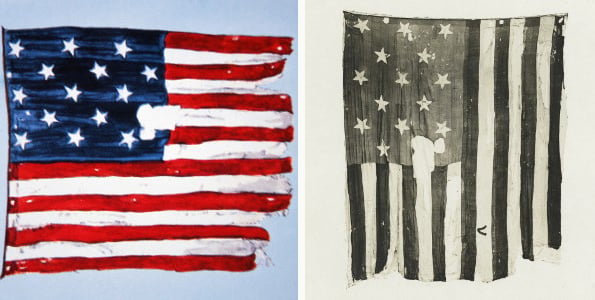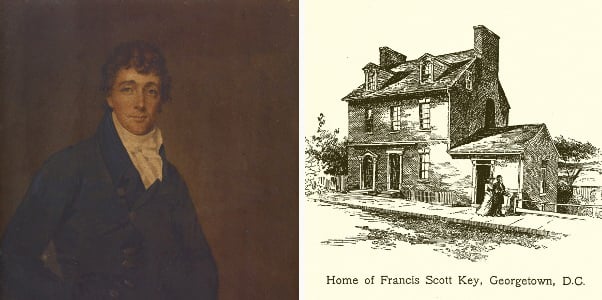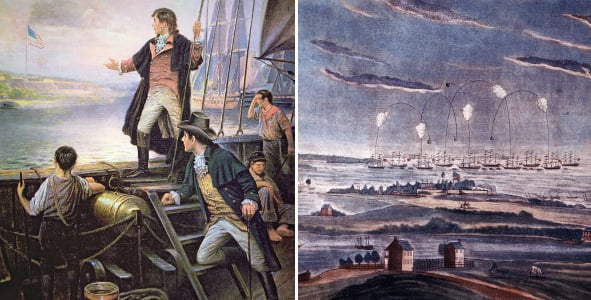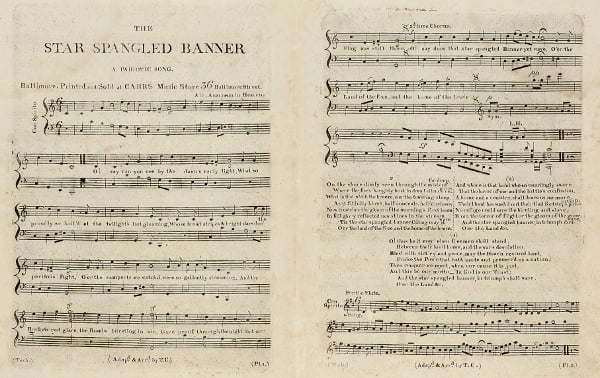
The Star Spangled Banner: 200 Years
To mark the 200th anniversary of one the world’s most recognizable songs, The Star Spangled Banner, here is a brief history of the national anthem of the United States

Left: The Original ‘Star-Spangled Banner’ / Peter Newark American Pictures
Right: The Original ‘Star-Spangled Banner’ / New York Public Library
200 Years of American pride
September 16th 2014 marks the 200-year anniversary of one of America’s most celebrated expressions of patriotism and national identity. Written by 35-year old Washington lawyer, Francis Scott Key, the “Star-Spangled Banner” had humble beginnings as a few poetic lines written on the back of a letter found in Key’s pocket.
Deeply religious, Keys dabbled mainly in religious-themed poems and verses. However, he was known by friends and peers more for his respectable work as a lawyer, not necessarily as an avid poet and patriot. The War of 1812 would certainly change that.

Left: Francis Scott Key / Joseph Wood / © Walters Art Museum
Right: Home of Francis Scott Key, Georgetown, D.C / © Look and Learn
A war that divided the country
In June 1812, the Senate and House of Representatives voted by a slim margin to declare war on the British. With opposition to the war focused heavily in the north, rumor spread that the Northeastern states should split from the Union to create their own distinct American nation. This served to demonstrate the floundering American identity and strong anti-war sentiment held by a majority of the American public, including Francis Scott Key.
August 24, 1814, British troops had successfully torched the Capitol building and key government structures. Key’s neighbor and prominent physician, Dr. William Beanes, had been arrested for allegedly aiding in the arrest of British soldiers. Outraged, Kes boarded the British vessel holding his friend to act as his legal representation. After gaining Beanes’s freedom, Key and Beanes had to anxiously watch the Battle of Fort McHenry from aboard the prisons of the British ship.

Left: The Birth of the US National Anthem / Peter Newark American Pictures
Right: The British Attack of Fort McHenry, Baltimore in 1812 / © Collection of the New-York Historical Society
Defense of Fort McHenry
The following morning they woke to see a massive American flag proudly waving from an undefeated American Fort McHenry. This display of American strength inspired Keys to put pen to paper about the experience while still aboard the British vessel. Entitled “Defense of Fort McHenry,” the verse Key wrote was accompanied by a suggestion that it be set to the music of the well-known “Anacreontic Song,” written by English composer John Stafford Smith. Rechristened “The Star-Spangled Banner” within weeks, Key’s inspired words began appearing in newspapers across the country. Despite its popularity, the song was not proclaimed America’s “National Anthem” until 1931 by President Herbert Hoover.
Key’s song still serves as a shining emblem for America’s cohesive national identity and everything strong and true that it embodies.

First edition of the sheet music for ‘The Star Spangled Banner. A Pariotic (sic) Song’, Baltimore, 1814 / Photo © Christie’s Images
Find out more
View our lightbox of Star-Spangled Banner images.
All images in this article are sourced from bridgemanimages.com. Contact the Bridgeman sales team for more information regarding licensing, reproduction and copyright.
Save
